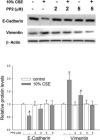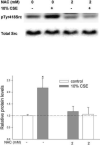Cigarette smoke extract stimulates epithelial-mesenchymal transition through Src activation
- PMID: 22342303
- PMCID: PMC3312989
- DOI: 10.1016/j.freeradbiomed.2012.01.024
Cigarette smoke extract stimulates epithelial-mesenchymal transition through Src activation
Abstract
Epithelial-mesenchymal transition (EMT) is implicated in the pathogenesis of lung fibrosis and cancer metastasis, two conditions associated with cigarette smoke (CS). CS has been reported to promote the EMT process. CS is the major cause of lung cancer and nearly half of lung cancer patients are active smokers. Nonetheless, the mechanism whereby CS induces EMT remains largely unknown. In this study we investigated the induction of EMT by CS and explored the underlying mechanisms in the human non-small-cell lung carcinoma (H358) cell line. We demonstrate that exposure to an extract of CS (CSE) decreases E-cadherin and increases N-cadherin and vimentin, markers of EMT, in H358 cells cultured in RPMI 1640 medium with 1% fetal bovine serum. Pretreatment with N-acetylcysteine (NAC), a potent antioxidant and precursor of glutathione, abrogated changes in these EMT markers. In addition, CSE activated Src kinase (shown as increased phosphorylation of Src at Tyr418), and the Src kinase inhibitor PP2 inhibited CS-stimulated EMT changes, suggesting that Src is critical in CSE-stimulated EMT induction. Furthermore, NAC treatment abrogated CSE-stimulated Src activation. However, co-incubation with catalase had no effect on CSE-mediated Src activation. Finally, acrolein, an unsaturated aldehyde present in CSE, caused Src activation. Taken together, these data suggest that CSE initiates EMT through Src, which is activated by CS through redox modification.
Copyright © 2012 Elsevier Inc. All rights reserved.
Figures









References
-
- Willis BC, Borok Z. TGF-beta-induced EMT: mechanisms and implications for fibrotic lung disease. Am J Physiol Lung Cell Mol Physiol. 2007;293(3):L525–34. - PubMed
-
- Gharaee-Kermani M, et al. Recent advances in molecular targets and treatment of idiopathic pulmonary fibrosis: focus on TGFbeta signaling and the myofibroblast. Curr Med Chem. 2009;16(11):1400–17. - PubMed
-
- Yauch RL, et al. Epithelial versus mesenchymal phenotype determines in vitro sensitivity and predicts clinical activity of erlotinib in lung cancer patients. Clin Cancer Res. 2005;11(24 Pt 1):8686–98. - PubMed
-
- Soltermann A, et al. Prognostic significance of epithelial-mesenchymal and mesenchymal-epithelial transition protein expression in non-small cell lung cancer. Clin Cancer Res. 2008;14(22):7430–7. - PubMed
-
- Baumgartner KB, et al. Cigarette smoking: a risk factor for idiopathic pulmonary fibrosis. Am J Respir Crit Care Med. 1997;155(1):242–8. - PubMed
Publication types
MeSH terms
Substances
Grants and funding
LinkOut - more resources
Full Text Sources
Research Materials
Miscellaneous

